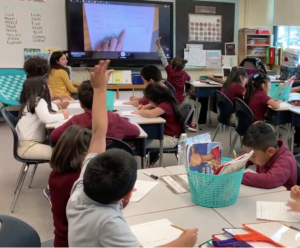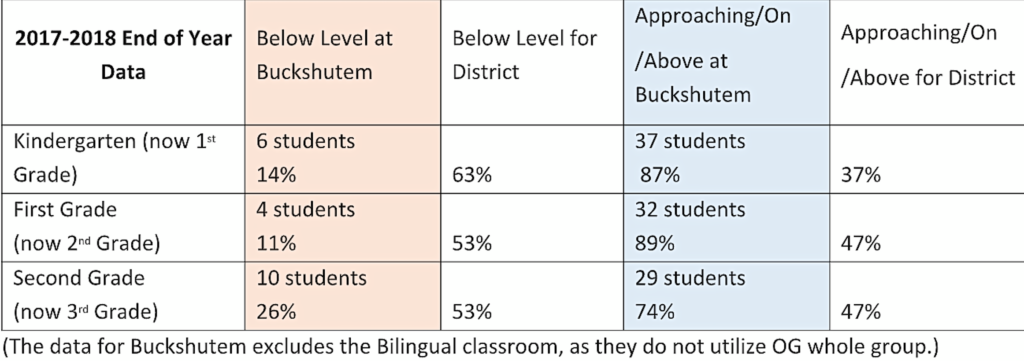
Bridgeton’s Thriving ‘Culture’ Of Reading With OG Method
Bridgeton, New Jersey is a medium-sized, but growing, working class community of just over 24,500 residents situated along the Delaware Bay. It’s the Cumberland County seat and home to a diverse range of inhabitants, representing many different cultures, nationalities, incomes and backgrounds.
At the heart of the community is its school district, where Barbara Wilchensky serves as the director of curriculum for language arts literacy, overseeing the district’s compliance with state reading laws and implementation of literacy programming, such as IMSE’s Orton-Gillingham.
With about 23 percent of the district’s overall population receiving some type of language service, such as ELL instruction, Wilchensky knew educators at her schools needed teaching tools that could reach all students, regardless of background.
Bridgeton was first introduced to the Institute for Multi-Sensory Education in 2015, when it sent its Response to Intervention team for a training.
“We needed to strengthen the foundational literacy skills of our students in the primary grades,” Wilenchensky said. We were realizing that by third grade, our students reading levels would began to fall. Students were unable to decode the increasingly difficult text and it was affecting comprehension.”
That year, RTI staff began using Orton-Gillingham among some of its kindergarteners, and by 2016, it was being implemented in all kindergarten classrooms throughout the district. Each subsequent year brought a new wave of IMSE’s OG training for the district’s elementary educators, with now all K-3 classroom teachers — as well as special education teachers, inclusion teachers, English as a second language teachers and even gym teachers — trained in the methodology and using it daily to teach students to read. Instructional assistants serving special education and kindergarten students also received phonological awareness training.
School-wide Commitment a Key to Reading Success
The end of the 2018-19 school year will mark the first year that third-grade students will have received the OG instruction each year since kindergarten.
“The teachers and I soon realized the value of Orton-Gillingham instruction and the impact it was having on our population,” Wilchensky said.
At Buckshutem Road School, one of the district’s elementary schools, Wilchensky noted that the school’s “commitment to OG instruction is what sets this building apart from the others. The positive results of the OG implementation at Buckshutem Road School are evident by the reading levels of their students.”
Teachers featured: Gabrielle Enders and Amy DeFeo
So far, the proof is in the numbers, Wilchensky said. Data provided by the district shows Buckshutem Road students enjoy significantly higher reading levels than other students when compared to the district average.

Wilchensky said she’s looking at how students are carrying over the decoding and encoding skills from IMSE’s OG instruction into their actual reading with fluency and comprehension.
By injecting OG into daily literacy lessons, as well as in other places outside the classroom, Buckshutem Road School in particular has created a “culture” of OG, she said.
“The biggest piece of success here is that it’s become a culture here,” Wilchensky said. “Everybody knows OG, everybody embraces it. Even in physical education, the P.E. teacher does teams related to red words and their sounds, there are red words posted in the hallway — even the students are taking the lead on red word drills in some classes.”
“This whole community here has really embraced it and that’s part of their success,” Wilchensky said. “Part of what the numbers show in the progress of students is just that buy-in.”
The teachers utilize IMSE’s OG each day during their whole group literacy block, making it a high priority — even going so far as to post their literacy schedule outside their classroom doors and their school administrators designate OG lessons as a “no interruption” period. . Teachers then reinforce the skills taught during OG whole group in literacy centers and guided reading sessions, and OG instruction is utilized in the afterschool programs, as well as the summer programs for Buckshutem Road School, Wilchensky said.
Data from IMSE’s assessments is regularly analyzed and compared to the Running Record assessments to track progress, and teachers utilize IMSE’s assessments for their Student Growth Objectives required by the state.
The intense focus on OG provides a common language for the teachers and promotes collaboration, Wilchensky said. The teachers have rewritten the district curriculum to include OG and designed weekly assessments for their colleagues across the district.
“The training that IMSE provided just lit a fire under the teachers, because it was unlike any training they’ve ever had,” she said. “They realized what reading instruction really needs to look like, and how specifically to help the students — and they were excited by that. Once they started seeing the success of the students, that fueled them even more. Our ultimate goal is to replicate this culture throughout all of our schools in order to increase reading achievement for all students.”
Teachers Seeing Results
One of those teachers is Jessica Lucas, a kindergarten teacher now in her fifth year with the district.
She took IMSE’s OG training several years ago and began incorporating the method into her daily literacy block, using it alongside another engaging technique meant to enhance students’ language skills: American Sign Language.
“We do a cute little alphabet song, and the kids learn the sign for each letter and the sound, too, so it really has helped them and they remember the sound with the sign a lot easier,” Lucas said. “So naturally with OG, it was really easy to incorporate signing into OG. They finger spell red words, when we do the blending board they finger spell all the letters as we’re doing it — I found that it really helps them make that connection solid between the letter and the sound, it’s like a mental image almost.”
“With OG everything is so hands-on and tactile, the sign language kind of fit into that same thing — it’s one more strategy, one more tool to give them that really helps them to make those connection and remember their letter sounds.”
Her class of 19 represents a diverse range of learners, with about half skewing toward high-achievers, and the other half split between average learners and those needing extra help, she said. Of the bunch, four are ELL students, two of whom receive pull-out services during the week.
Still, her OG lessons have something for everyone, she said.
“There’s so many different components to it, so even if one thing we’re doing is resonating with only some students, there’s something else we’ll do later in the lesson with that same letter and sound that those students who missed it the first time will get it a different way,” Lucas said. “Whether it’s the sand trays, or it’s the workbooks, they kind of get every different angle of that sound and it’s getting through to them.”
Feedback Lucas has received from teachers in higher grades who now have students that have gone through OG in kindergarten say their students are coming in more prepared than in previous years, as well.
By laying the basic foundations of reading during kindergarten, first grade students have had to spend less time reviewing and more time furthering learning, she said.
“We’ve heard from the first grade teachers, too, that kindergarteners who’ve received OG are a lot more ready for first grade writing,” she said. “They’re able to sound words out a lot more fluently without needing all that extra help. I can definitely see in my classroom that by February the majority of kids are either at or above reading level for kindergarten. It’s definitely given them all those foundational skills early on that they’re just able to build upon.”
It’s been a consistent, major improvement from when Lucas first started teaching, she said.
“From the first year when I taught kindergarten and we weren’t yet trained in OG, to now, I can definitely notice a big difference on how quickly they’re able to read, and how quickly they’re able to write and understand how to sound words out — whereas before that was kind of something we didn’t see much of until toward the end of the school year,” Lucas said. “Now, even at the start of the year, they’re doing it in their journals. They’re already sounding words out, they’re already writing sentences with their red words, so OG has really helped them to be able to do that a lot quicker.”
Lucas attributes the success to the skills she learned during her OG training with IMSE, picking up on theories and techniques she never learned as either an elementary student herself or as a burgeoning teacher.
To ensure her students continue to meet and exceed reading benchmarks in-line with state law, Lucas said she now relies on OG to reach all of her students, even those who have traditionally struggled with reading.
“I remember sitting in the OG workshops and thinking, ‘Wow, nobody ever taught me this,’” Lucas said. “There were so many techniques and tricks and memory cues that we got in the training that I wish I had when I was in grade school, even. Then when you’re in college to become a teacher, they don’t really hone in so much on how to actually deliver the information to students that maybe don’t understand it, how to break it down for them — but with OG, it breaks it down to so many different levels.”
Learn more about the Institute for Multi-Sensory Education’s Orton-Gillingham training.
